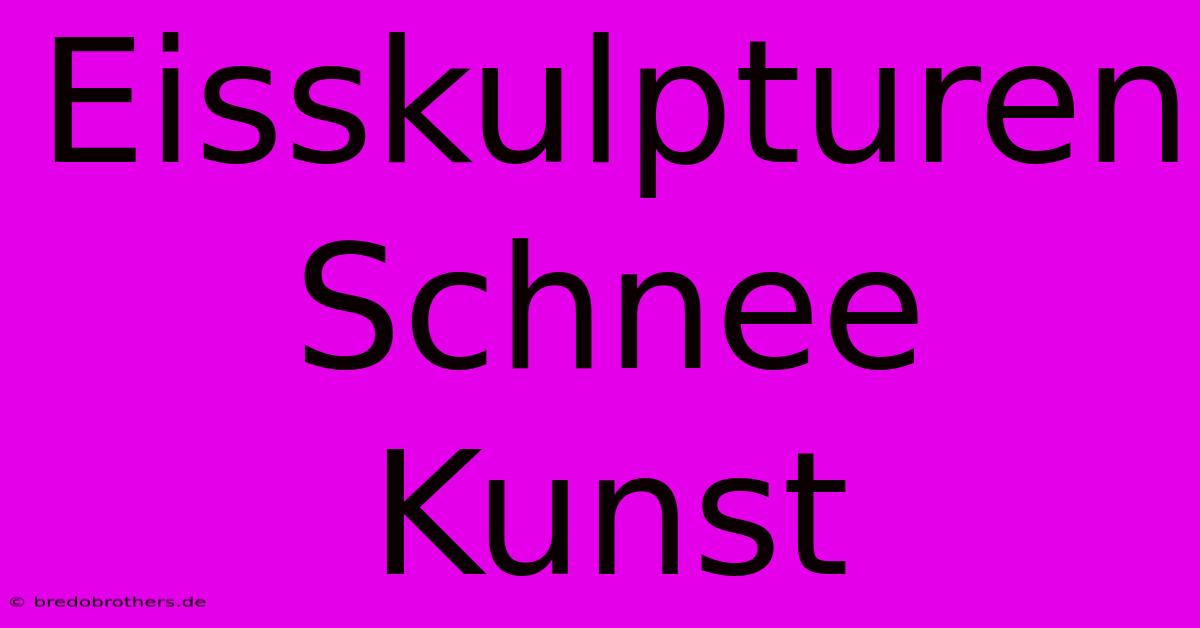Eisskulpturen Schnee Kunst

Discover more detailed and exciting information on our website. Click the link below to start your adventure: Visit Best Website Eisskulpturen Schnee Kunst. Don't miss out!
Table of Contents
Eisskulpturen: Schnee Kunst – Meine Abenteuer mit Eis und Schnee
Hey Leute! Let's talk about Eisskulpturen – ice sculptures – and Schnee Kunst, snow art. I've always been fascinated by it, ever since I saw those amazing ice hotels on TV. Seriously, breathtaking! But my own journey into this frosty world? Well, let's just say it's been… eventful.
My First (and Frosty) Failure
My first attempt at making an Eisskulptur was, uh, a disaster. I envisioned a majestic swan, graceful and elegant. What I actually ended up with was something more resembling a melting, lopsided… well, something. It looked nothing like a swan. I used a regular garden hose to fill my molds, and it took FOREVER. The water froze unevenly, making the whole thing crack and crumble. I spent hours outside in the freezing cold, only to have my masterpiece collapse in a puddle of icy disappointment. Talk about a cold, hard lesson!
Learning from My Mistakes: Practical Tips for Ice Sculpting
So, what did I learn? Plenty! Firstly, proper mold preparation is KEY. I discovered that using silicone molds, rather than the flimsy plastic ones I initially used, makes a huge difference. They're more durable and allow for cleaner, more intricate designs. I also learned about using distilled water – this prevents cloudy ice and makes your sculptures much clearer. And who knew that a simple spray bottle could be used to add that extra detail during carving? Using a spray bottle makes the ice slightly wetter which allows you to blend shapes better.
Secondly, temperature control is EVERYTHING. Freezing your molds slowly and evenly is crucial. Rushing the process, as I did, leads to cracks and inconsistencies. A consistent sub-zero temperature is what you need. The ideal temperature is -10 degrees Celcius for good results. Believe me, I found out the hard way!
Schnee Kunst: Snow Art Adventures
Moving on from ice, I also tried my hand at Schnee Kunst, snow art. This was a slightly less disastrous experience, though still challenging. I attempted a snow angel – a classic, right? But the snow was too wet initially and I ended up looking like a snow-covered blob rather than an elegant angel. And, a little trick, packing the snow firmly is crucial, it helps create strong sculptures.
Tips for Creating Awesome Snow Sculptures
For Schnee Kunst, the type of snow is crucial. Dry, powdery snow is best for building snowmen and sculptures that hold their shape, whereas wet, sticky snow is better for packing and creating smooth surfaces. I learned to take the time to pack the snow densely. That is what keeps a snow sculpture from melting as quickly.
I also discovered the power of simple tools. A small shovel, some sturdy sticks, and even a simple kitchen knife can be used to create amazing snow sculptures. You can easily carve out details. Don't underestimate the importance of layering snow, too, for strength and stability. You need to be patient with this. Don't rush the process.
Conclusion: Embrace the Frosty Fun!
So, my adventures in Eisskulpturen and Schnee Kunst have been a mix of epic fails and small victories. But that's the beauty of it, right? The learning process is part of the fun. Don't be afraid to experiment, embrace the mess-ups, and just enjoy the creative process. You might surprise yourself with what you can create! Plus, who doesn't love a good snowball fight afterwards?
Remember to dress warmly! It's seriously cold outside. And yeah, invest in some good quality gloves. Trust me on that one.

Thank you for visiting our website wich cover about Eisskulpturen Schnee Kunst. We hope the information provided has been useful to you. Feel free to contact us if you have any questions or need further assistance. See you next time and dont miss to bookmark.
Featured Posts
-
Bayern Munchen Zu Null In Der Cl
Nov 27, 2024
-
Lotto Gewinn Verpasst Handeln Sie Jetzt
Nov 27, 2024
-
Lukebas Einfluss Leipzigs Harter Tag
Nov 27, 2024
-
Abbuchung Klagenfurt Zehntausend Euro Verlust
Nov 27, 2024
-
Champions League Manchester City Kampf
Nov 27, 2024
